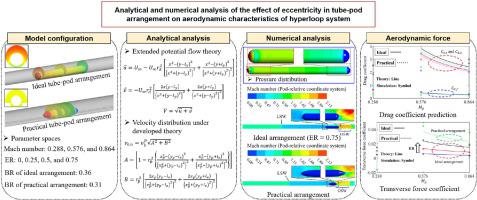当前位置:
X-MOL 学术
›
Int. J. Mech. Sci.
›
论文详情
Our official English website, www.x-mol.net, welcomes your feedback! (Note: you will need to create a separate account there.)
Effects of eccentricity in tube–pod arrangements on hyperloop aerodynamics
International Journal of Mechanical Sciences ( IF 7.1 ) Pub Date : 2024-06-23 , DOI: 10.1016/j.ijmecsci.2024.109505 Jihoon Kim , Changyoung Lee , Thi Thanh Giang Le , Dokyun Kim , Yoonjin Won , Minki Cho , Jaiyoung Ryu
International Journal of Mechanical Sciences ( IF 7.1 ) Pub Date : 2024-06-23 , DOI: 10.1016/j.ijmecsci.2024.109505 Jihoon Kim , Changyoung Lee , Thi Thanh Giang Le , Dokyun Kim , Yoonjin Won , Minki Cho , Jaiyoung Ryu

|
The hyperloop, proposed as an innovative tube-train system, offers numerous transportation advantages yet exhibits inherent asymmetries arising from the design of the tube and the positioning of the pod. This asymmetry results in imbalanced forces on the pod, a factor often overlooked in studies that assume an idealized tube–pod arrangement. This study conducts a numerical analysis on the influence of pod eccentricity on hyperloop aerodynamics, specifically focusing on the pod Mach number () and eccentricity ratio (ER). Utilizing an analytical model under isentropic and potential flow conditions, this study theoretically predicts aerodynamic characteristics such as drag and transverse force coefficients related to the ER for the first time. Additionally, it explores the aerodynamic characteristics of practical tube–pod arrangements, revealing the effect of variations in the local cross-sectional areas around the pod nose and tail on airflow dynamics. In the local small cross-sectional area, an increase in ER correlates with higher flow Mach numbers and decreased pressure. Conversely, in the local large cross-sectional area, the effect of ER on flow quantities is minimal. The study revealed that while aerodynamic drag remains largely unaffected by ER, variations in both ER and significantly influence the transverse force in the direction closest to the tube wall. Moreover, the length of the oblique shock wave (OSW) behind the pod decreases with increased ER, with negligible effects on the leading shock wave (LSW). For a practical tube–pod arrangement, the trends in drag coefficients mirror those of idealized setups. A transverse force coefficient in the direction closest to the tube wall is noted at a pod Mach number of 0.288, with consistent patterns in the transverse force coefficient starting at a pod Mach number of 0.576. These findings provide crucial insights into the aerodynamic and aerothermodynamic characteristics of hyperloop systems, potentially guiding future design enhancements.
中文翻译:

管荚排列偏心率对超级高铁空气动力学的影响
超级高铁作为一种创新的管道列车系统,具有众多的运输优势,但由于管道的设计和吊舱的定位而表现出固有的不对称性。这种不对称性导致吊舱上的力不平衡,这是假设理想化管吊舱布置的研究中经常忽视的一个因素。本研究对吊舱偏心率对超级高铁空气动力学的影响进行了数值分析,特别关注吊舱马赫数()和偏心比(ER)。本研究利用等熵和势流条件下的分析模型,首次从理论上预测了与ER相关的阻力和横向力系数等气动特性。此外,它还探索了实际管-吊舱布置的空气动力学特性,揭示了吊舱前端和尾部周围局部横截面积的变化对气流动力学的影响。在局部小横截面积中,ER 的增加与更高的流量马赫数和降低的压力相关。相反,在局部大横截面积内,ER对流量的影响最小。研究表明,虽然空气动力阻力在很大程度上不受 ER 的影响,但 ER 和 ER 的变化都会显着影响最接近管壁方向的横向力。此外,吊舱后面的斜激波(OSW)的长度随着ER的增加而减小,对前导激波(LSW)的影响可以忽略不计。对于实际的管荚布置,阻力系数的趋势反映了理想化设置的趋势。在吊舱马赫数为 0 时记录最接近管壁方向的横向力系数。288,从吊舱马赫数 0.576 开始横向力系数具有一致的模式。这些发现为超级高铁系统的空气动力学和空气热动力学特性提供了重要的见解,可能指导未来的设计改进。
更新日期:2024-06-23
中文翻译:

管荚排列偏心率对超级高铁空气动力学的影响
超级高铁作为一种创新的管道列车系统,具有众多的运输优势,但由于管道的设计和吊舱的定位而表现出固有的不对称性。这种不对称性导致吊舱上的力不平衡,这是假设理想化管吊舱布置的研究中经常忽视的一个因素。本研究对吊舱偏心率对超级高铁空气动力学的影响进行了数值分析,特别关注吊舱马赫数()和偏心比(ER)。本研究利用等熵和势流条件下的分析模型,首次从理论上预测了与ER相关的阻力和横向力系数等气动特性。此外,它还探索了实际管-吊舱布置的空气动力学特性,揭示了吊舱前端和尾部周围局部横截面积的变化对气流动力学的影响。在局部小横截面积中,ER 的增加与更高的流量马赫数和降低的压力相关。相反,在局部大横截面积内,ER对流量的影响最小。研究表明,虽然空气动力阻力在很大程度上不受 ER 的影响,但 ER 和 ER 的变化都会显着影响最接近管壁方向的横向力。此外,吊舱后面的斜激波(OSW)的长度随着ER的增加而减小,对前导激波(LSW)的影响可以忽略不计。对于实际的管荚布置,阻力系数的趋势反映了理想化设置的趋势。在吊舱马赫数为 0 时记录最接近管壁方向的横向力系数。288,从吊舱马赫数 0.576 开始横向力系数具有一致的模式。这些发现为超级高铁系统的空气动力学和空气热动力学特性提供了重要的见解,可能指导未来的设计改进。












































 京公网安备 11010802027423号
京公网安备 11010802027423号